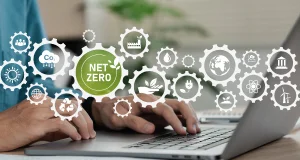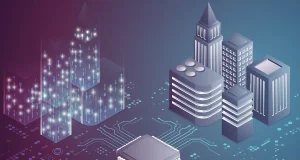Hi there, it's me again, my name is Neerja and this is tech lyceum. Now in this episode, we are covering everything from plants of the future, to the next paradigm shift in manufacturing and to help us and give us all the insights we have to experts today. First up, we've got Shamdutt Kamble that come play who is the Associate VP digital manufacturing at Birlasoft, Sham has nearly 30 years of incredible experience in Smart Manufacturing, digital twin, industrial automation and analytics. He has successfully driven numerous plans of the future initiatives right from building strategy to execution and implementation across the manufacturing domain. We've also got Rakesh Maheshwari, who is the Associate VP and global delivery head for discrete Manufacturing Services at Birlasoft. He has more than 20 years of global experience and has anchored diverse roles across delivery excellence, account management, program and portfolio management, practice management, product quality engineering, pre sales and bid management, ultimately, driving accelerated business outcomes for organizations. It's great to have both of these experts on the panel today, and I'm excited. Let's go right ahead and welcome them to the show. Hi, Sham. Hi, Rakesh. Thank you for being here.

Nice. Thanks, Neerja, super excited to share my experience and reflect on my experience around the topic what we are going to discuss today.
Thanks Neerja, very excited to be here.
Let's get into this topic. Rakesh and Sham based on your customer engagements,
Q: How do you see the current state of the manufacturing industry in terms of customer needs or demands? And what are the top three motivators behind setting up plants of the future? Rakesh, maybe you can start us off
Surely Neerja. What we see in the marketplace is surely a customer preference shift. emergence of new distribution models is for real. The geopolitical uncertainties are definitely impacting all of us. The supply chain disruptions have impacted all of us in the last few years, and years, the regulations are definitely becoming more binding right. Now, with all of this weird Billa soccer definitely seeing rise of new opportunities, in terms of redesigning and innovating existing business models. The trend is truly global. With over a trillion dollar investment already going into factory transformation initiatives. All operators focus on building resilient hrl supply chains, powered by digital technologies. Whether it does matter was predictive and advanced analytics or digital twins, right? All these investments are primarily focused towards increasing supply chain network visibility, with control and coordination. There's a trend that we see in North America, where in Europe, the trend is definitely more targeted towards greener operations with waste and recycling technologies implementation to meet a net zero targets. Manufacturers are committed to. Even with manufacturing resurgence in India, where industrial manufacturers are showing an upward trend towards digital technology adoption, with an implementation rate of as high as 55%. But a recent PwC survey, while business models based on Servitization, together with cost efficiencies and workforce and workplace safety, are the current business hot buttons. There is definitely increasing interest in utilizing generative AI, the flavor of the season to develop customized solutions for optimization of business operations as well.
Interesting, Rakesh, thank you for those keen insights and Sham. Could you add on to that there?
just to add on to what Rakesh and just to sum up right, by and large, if you take the displayed of this manufacturers are we this area, like whether it's their design, what we call as a product lifecycle management phase, or whether it's production value chain, or supply value chain beat all this cross section of this three value chain, by and large, the focus of, let's say small medium, is to see how they can make their manufacturing process more leaner, right, so that they can make the process more robust, can reduce on their losses, reduce on the cost that goes into no manufacturing parts product. So that's number one. So by and large, if you see the traffic most of the traffic lights into this, but as we move up and get into the mid and last segments, then the focus on the motivator for them is how can I make more my system more resilient, whether it's my supply chain, whether it's my manufacturing line? For any disruptions or disruptions that can happen? How can I quickly record how can without loss of much functionality I can still be On time, still have that quality as specified as required. Right. And then to add to it, as we move towards little larger segments who are more mature in this hierarchy of industry for Dotto, the focus more is on the rigging of the agility. What is mean now is how can I make my process more flexible? How can I make it more adaptive, and then backed it by more, making my process reliable, and sustainable. Of course, the last two points, what I'm saying indicates more towards moving a ship from industry forward or to industry for time for it auto, which we'll be talking later in this session. Okay. But these are the by and large, the motors, which is driving this whole plant of future.
Interesting. Okay. And, Sham, let me follow that up with this question. You interact with customers day in and day out? Right?
Q: What are the top challenges manufacturers are facing when it comes to taking it to the highest level of maturity and scale?
To absolutely see, as I just said, right, the large scale manufacturers who have taken the lead, and in every domain, whether it's an district manufacturing, automotive Life Sciences, or even in the oil and gas operations, they have taken the lead. And yes, the challenges are there are more different. But if you see the whole, as I said, the traffic or the, the bulk of the if you will, to say like, you know, the traffic around the small scale, or limit scale size companies who have just taken off and want to be at that level highest level of maturity, couple of or handful of challenges are there. Okay, around that. Number one, and this is based on our experience, when we get into the consulting mode with our customers, or we deliver the product to the customers. A what we have absorbed is the clear understanding of their business goals, and its know how it gets mapped to their processes and systems to their pain point. So by and large is like what is my entry point all this journey? Okay, that's number one. That's not very clear, even after multiple of meeting. Number two is the use case, even if they identified use cases for this journey. The issue is with the normalization of the use case, what I mean by normalization is, the Center team was driving this initiative of industry, Ford auto Lynnie organizational enterprise have a view of let's say, having 13 plans of what incomes or 20 plants. But when it comes to the industrial plant, the plant or the local team, for the same use case, whether it's a production quality, inventory or maintenance will have a very different view. And that's where there is no cross level agreement, or the agreement is there in the bits and pieces. So that's the number second challenge, okay. When we move to this, and cross the use case challenges or the understanding challenges, the challenge comes down to the plant systems and the process of readiness, in terms of connectivity in terms of integrations of complex operational process data, business data, right. So there are still gaps, there are still some legacy machines, which they don't talk about. So that's another challenge. Once we cross this, the next level challenge is, okay, fine. This is all great. But how can how can we do the performance benchmarking? Okay, if you take certain KPIs and metrics for the improvement, let's say a to b, what is my A what is the right way to measure why whether it's a productivity, throughput quality, so that's also I have seen in most of my customers, each of their division comes up with different understanding different way they measure, and hence there is no normalization on that point to okay. But I want APO and beyond all this was important is, so we shouldn't Shams in the organization management, because when you'd like this type of deal programs, it's no longer the old roles are relevant, you have to end up some new roles from digital standpoint, where they will do a lot of fit gap, analysis gap closures to make a seamless experience. So those roles are missing. And once you roll out those pure pilots or POC then there is a culture of change management gaps where the lowest level of operators or the supervisors are not very trained, or it's a very different experience for them to get into day to day operations using this technology. So these are some challenges we face when we talk about no deployment of features and specifically from the industry perspective.
Wow. Okay, that's a list of challenges the birth cause challenges do plant the seeds for creativity. So that's one way to look at it and Sham. And Rakesh, we'd love for both of you to weigh in on this. Because Sham, you've just told us about these challenges, but given that this is what we are faced with, what does the future look like? And what is the way forward for manufacturers to unfold these future opportunities? Sham, if you'd like to start us off?
Sure Neerja, So talking about the challenges, and that's it right over the challenges, the market is not waiting for you. Okay? Remember that, if you see it's changing every day, every hour, every minute. And it's putting a lot of pressure in terms of eat coming with customized productions, coming up with personalized productions, your regulatory compliance norms are getting more tougher and tougher. Okay? The challenges with supply chain resilience is ongoing, right. And on top of that, there are environmental conditions norms are coming out. And in Europe US, specifically, those are taking in the highest priorities. Sustainability is became so because of the inflation that's coming in cost has gone up, how can we manage those costs. So which means even, I've just talked about like small scale bigger scale the laggard and trying to pull up their sleeves and socks to get to there. But these challenges are not going to wait for them. So what does it means is, really, they have to focus in terms of the practice of their use cases, getting more clarity of their use cases, identify the technologies, what they want to go with, and build those use cases, and move, keep their journey moving from level two to level three to level four. So that they are more resilient, more having more robust processes. And then reliability and sustainability. Is that to be talked about, okay? But that's it. The larger point, what I want to make is, you can't just keep waiting for your internal systems to be fixed. For your organization, organization management to be fixed. It's, we have to get into those aspects, find out where are the gaps come, what are the pain points and keep moving into the the ladder of the maturity of industry for Dotto, and once you're there, then you think of how I can be no future really, in terms of industry 502, okay, because these are the fundamental the foundation that's going to build your industry find out this is how the way forward and of course, lots of best practices, governance, internal culture, change management, so forth, along with the technology will happen and I think we'll talk about those in the next session.
Absolutely. And Rakesh, your thoughts on this as well. So
So Neerja, we are certain that the future of manufacturing needs to be sustainable, human centric, and resilient to external shocks and adversities we are looking at more meaningful and effective collaboration between all elements of digital ecosystem, whether it is humans, machines or systems, placing the wellbeing of the workforce, what we refer to as human in the loop will be at the center of the production process. And whether it is use of new technologies to provide prosperity beyond jobs and growth, while of course, respecting the production limits of the planet, or creating high value employment with larger freedom for design thinking and creativity or whether it is building mass customization capabilities as business differentiator or improved visibility and insights into production and service operations. Effective execution of chain management strategy with senior leadership is sponsorship, deeper collaboration between central teams and local plant and implementation site teams and agree design I sham also indicated will be key to successful pilots and faster rollout for a scale adoption of industry 4.0 and beyond.
All right, exciting opportunities lie ahead. It sounds like gentleman can both of you share some closing thoughts on the best practices for manufacturers that they can follow to be ready for this paradigm shift in manufacturing?
Yeah, absolutely. And these are very basics and fundamentals, no rocket science here, I would recommend like an in this again, based on my experience with most of my manufacturers are taking the path is to start small, identify the use cases, which will really address the immediate pain points and start giving them the value. So that builds in the confidence with a sponsor, they hire management, and this fuels your further roadmap and the progress of that Okay, so that's number one. While you do that, also keep the big picture in the mind okay, also think big, and see that how can I take the small steps, identifying let's say the use cases around equality overproduction inventory. How can I extend it further for my larger, bigger goal, to make my systems more self optimized self organization, so forth and so on. So that's the key, okay? Don't start something where you will not see immediate benefits coming in, though it is something good to have or something very glamorous to say, Okay, we are getting into industry fold, find out oh, but if it is not going to solve the immediate problem, it's not going to show you the ROI. That's not going to build it to your confidence into the top management or the sponsor of this particular program. Okay, so that's one. Second is start aligning your IT OTT systems for the roadmap and for the journey, okay. And one of the solution is, don't go top down on that, meaning, like, you have certain technology in your mind, and then start displacing, removing whatever existing things, or existing technologies you're having that will take a lot of time and investment. So the solution is that bottom up, see what you have currently technologies in terms of the IT OT and ET, try to build on top of it, to drive the use cases what you have identified, so that way, it is a faster path. And you will see the faster returns on those things. Okay. That's it on these two points. It has to be absolutely backed up with the management commitment, okay, with proper governance structure to it for the effective culture and automatic change management. So that's the mantra I would say, to keep focus, keep following and continuously reviewing the progress on top of it, to see with respect to what was planned and what has been achieved, what is the outcome we have achieved and then what improvements we need to do so there's how keep the engine going.
Perfect. Yep. And Rakesh, your closing thoughts on the subject?
So Neerja, in my mind, I'm very clear that focus on developing workforces skills and capabilities, focusing on business problem first, and leveraging technology only as an enabler following a bottom up approach, right. The sham also alluded to building up our ecosystem of right system integrators, executive leadership, and effective change management practices will all be key to scaling plans with a future strategy and transition to the next level of maturity stage. We see that happening with many of our customers in high tech, auto mobile, med device, aerospace and different segments who are taking a leap. And I would strongly advise manufacturers across industry segments of all size and scale to take the giant leap forward and act on it now. Even at our end at Birlasoft we are currently located to drive business transformation opportunities for our customers. And the recently launched generative AI Center of Excellence in partnership with Microsoft aims to expedite the same right by increasing the value creation innovation opportunities, combining Birlasoft, deep industry experience that has European AI services.
Right. Well, Rakesh Sham, thank you for giving the listeners such a thorough understanding of this subject. And we sure hope to have you back on tech Lyceum because you are a powerhouse duo. So thank you for joining us.
Thank you, Neerja
Thank you Neerja. Thank you very much.
Well, as always, that was a very thought-provoking episode. I hope you enjoyed it. There's a lot more where this came from. We're always bringing on experts and having some very interesting discussions. So make sure to join us again when we're back. Until then it's me Neerja signing off for now. Bye bye.




